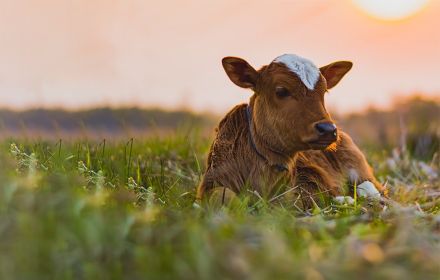July 29, 2021 was “Earth Overshoot Day”. That’s the point at which humanity’s resource consumption exceeded the planet’s natural capacity to support life for the entire year. For the following five months and two days of 2021, the world was essentially borrowing its resources from the future.1
It has become clear that the planet does not have the natural resources needed to support infinite growth. Recognizing that the planet has finite resources and responding to this can shape the global food system in coming years. This creates significant opportunities for organizations that can evolve their operations and business model to produce food in a way that balances the demand for food with nature and biodiversity in the widest sense. If we collectively fail to take care of nature, we will not be able produce the food we need to function as a society.
We have developed complex global food systems over the last fifty years to feed a rapidly growing population at a cost that is affordable to all. For most, although not all, the food system delivers. The COVID-19 pandemic and the associated supply disruptions have highlighted the system’s frailties, while an increase in extreme weather events has challenged the resilience of producers and driven a strong focus on securing yields in the short term. Collaboration across the entire food system – from farmers, growers and fishers through to processors, retailers and consumers– is required to develop a broad perspective of a modern food system that can feed the global population while maintaining a balance with nature; a system that fuses traditionally grown foods with future food, produced using techniques such as culturing, cellular and fermenting, to supply highly nutritional and affordable food.
Why ‘investing in a healthy planet’ is critical to the food industry
Recent work with the World Business Council for Sustainable Development, applying KPMG’s Dynamic Risk Assessment methodology to the risks inherent in the global food system, highlighted that the combination of climate change and episodic weather events with other risks (including a focus on short term outcomes over long term consequences of farming systems, diminishing biodiversity, a deterioration in soil quality and a primary focus on scale) could have a material adverse impact on the ability of the global food system to meet its main goal of feeding society. This analysis also highlighted that focusing efforts on steps that could mitigate the impact of climate on our food system and doing so with a long term focus and strong regard to how farming systems interact with nature are amongst some of the most practical steps the food industry can take to enhance the system and help ensure economic and environmental resilience is enhanced. In a practical sense, this means organizations are looking to explore alternatives such as:
- new technologies that enable yields to be enhanced while striving to minimize inputs and the use of natural capital;
- transitioning towards more sustainable/regenerative forms of farming;
- taking farming systems off the grid and using renewable energy sources;
- shifting towards circularity in food and crop production systems – particularly the development of bioproduct solutions to utilize the biomass produced in agriculture.
Glimmers of progress
The overall goal is to increase the resilience of the global food system to provide enhanced food access and nutrition to the global population, while also driving material changes in how the system interacts with nature. Progress is beginning to be made in some areas.
There is much greater awareness of food waste and how it diminishes the planet’s finite resources. Food is going to waste in some parts of the world, while food insecurity is on the rise in others. The need for a global levelling up has become even more urgent recently with more people at risk of malnutrition while food sits unharvested in the fields due to political unrest.
Water insecurity is also a significant issue, with more than two billion people who are currently living in regions with water stress. The food system globally uses about 70% of fresh water and is being challenged to help reduce its demands. There is a significant amount of technology development regarding smart water management – a key area of investment in the food system.2
There are also growing efforts to use co-products that are produced in growing food to assist in decarbonizing society, seeking ways to use biomass to generate energy and delivering other bioproducts to replace products traditionally made from fossil fuels. There’s also more emphasis on modern, accelerated breeding techniques that can produce cultivars that have less impact on nature and generate co-products that are more useful for society.
Designing a modern circular system to feed the world
The signs of progress show how important it is that every link across the food system is actively collaborating to deliver strategies and solutions that can help create a modern, circular food system that gives as much back to nature as it takes out.
The shift towards circularity in production systems (particularly the development of bioproduct solutions to utilize the biomass produced in agriculture) is already being recognized and addressed in some companies that are exploring a variety of interesting strategies and innovative solutions.
Other companies, and even entire communities, are looking holistically at the resources available in their precinct or region and seeking ways to help optimize resource use and waste streams. This includes linking water reserves, biodiversity corridors, emissions or heat from processing, nutrient streams and recycling of materials.
We all play a role
Historically, we have tended to segment issues in the food system (and the responsibility for addressing them) with the view that ‘agribusiness is the responsibility of the growers, retail is for the retailers, and production is for the processors and distributors’. This is no longer the case. The industry can’t choose to tackle some issues in the value chain, while not addressing others.
The responsibility to nature does not rest on the shoulders of any particular segment of the food industry, it rests on the shoulders of the industry as a whole. What is needed is a wide-ranging food chain perspective to help achieve a healthy planet and healthy people. And every link in the chain from the farm to the table has an important role to play.
In this integrated global food system, the power of consumers is increasing exponentially. They sit in the middle, making the food system more of a “value web” than a value chain. With their unique perspective (and power), consumers have the ability to influence the changes that need to happen at the level of farm operations and all the way through to the ingredients they choose for the dinner table. With the use of technology, consumers can see what’s happening at different points throughout the system. That enables them to influence the ethical operations of retailers and the degree to which value is being shared equitably across each link in the chain.
The issues facing the food industry are complex, but the message is simple: if we don’t look after nature, we ultimately can’t look after our communities. We should invest in our planet and our future as a global community if we want to feed ourselves.
Connect with us
Connect with us
- Find office locations kpmg.findOfficeLocations
- kpmg.emailUs
- Social media @ KPMG kpmg.socialMedia
Related content
Footnotes:
1EarthOvershootDay.org
2Worldwildlife.org




